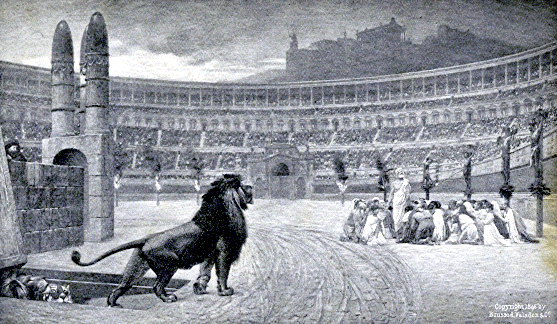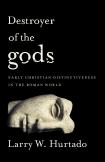A convicted and crucified peasant
The history of early Christianity writ large takes the form of a compare-and-contrast essay with multiple authors, ancient and modern. How did this unexpectedly successful religious movement “retain a certain level of continuity with its cultural setting” and yet also “maintain a medium level of tension” with its surroundings? How did it carry forward enough traditions of Judaism to enjoy the benefits of ancestral antiquity, while attracting non-Jews toward the worship of the God of Israel? How did it use ideas, genres and rituals recognizable to Greeks and Romans, while generating new forms of belief, literature and bodily obligations? In short, how did Christianity have “distinguishing features that set it apart in its cultural setting,” while avoiding “being seen as completely alien or incomprehensible?”
Larry Hurtado, emeritus professor at the University of Edinburgh, writes the “contrast” portion of the multi-authored essay we call history. As a citizen of the modern Western world, he is concerned that “there is a widespread presumption that all religions are basically the same” and also a “cultural amnesia” about the features of earliest Christianity that made it “odd, bizarre, in some ways even dangerous.”
These assessments, with which his new book begins, may ring true in a few contemporary locales. But the more widespread story is that the religion of others remains “odd” and “dangerous”: bans on burkinis or circumcisions in Europe, bombs at churches in Egypt, murders of Sikhs in the United States. Nonetheless, one does not need a modern point of departure to appreciate Hurtado’s work as a historian of antiquity. He is correct that most in this scholarly field lean toward the “compare” side, and his work is a beneficial counterweight.
Through five smooth chapters aimed at a general readership, Hurtado emphasizes: first, how ancient outside observers of Christianity explained its weirdness; second, how Christians offered a “novel mutation” of Jewish beliefs and traditions; third, how they cultivated a new identity that was translocal, transethnic, voluntary and exclusive; fourth, how they became a “bookish” religion; and fifth, how they championed behavioral demands that set them at odds with the dominant culture.
The book shines in the two areas for which Hurtado is most renowned: articulating how ancient beliefs about Christ’s divinity emerged from within Judaism (see his Lord Jesus Christ: Devotion to Jesus in Earliest Christianity) and documenting the rise of Christian book culture (see his The Earliest Christian Artifacts: Manuscripts and Christian Origins). He treats the latter topic especially well and thoroughly challenges the oft-repeated idea that early Christians primarily lived in an oral and visual culture.
Larry Hurtado worries about a “cultural amnesia” about the features of earliest Christianity that made it “odd, bizarre, in some ways even dangerous.”
The most original chapter of the new book is “A Different Identity,” which shows great promise but remains underdeveloped. Here Hurtado takes on the multivariable problem of identity, which might encompass genealogy, gender, locality, transiency, ritual, belief, polity, class, voluntary associations, hierarchical status, among other factors, all of which might be run through a critical apparatus drawn from sociology, cultural anthropology, literary theory, gender studies, ritual studies, political theory or some other mode of analyzing information. Describing the origin of early Christian social identity is the life’s work of other scholars in the way that the origin of early Christology is for Hurtado. His broad knowledge of ancient evidence does lead to some clear lines drawn and categories to think with, but the picture would also leave a general reader with a sketchy sense of Christian social identity.
Other ancient cultic associations besides Christianity were translocal and transethnic, for example, the worship of a ruler like the Roman emperor, and many were voluntary, like the spread of the Egyptian goddess Isis or the Persian god Mithras. Each of these three offers for Hurtado “a partial analogy for the way that early Christianity, whether in its earliest ‘Jesus-movement’ form or later, likewise made an appeal to individuals transethnically and translocally.” The crucial distinguishing feature, then, is “the demand placed upon all Christians that they must make their Christian commitment the exclusive basis of their religious identity.”
The rigidity of these identity characteristics could be softened with further evidence. While it is true that Christianity was transethnic in one sense, the resiliency of ethnic categories in early Christianity completes the story. As early as Matthew, Christians are conceived as a “new ethnos,” while 1 Peter uses “chosen genos“ and “holy ethnos.” Paul’s communities take up a collection of money not to give to the poor generally but to send to Jerusalem specifically as a translocal ethnic bond; he calls his non-Jewish converts “the Israel of God.” And genealogical connections to Abraham or David are sites of contestation for most New Testament authors. Most ubiquitously, Christians use familial language, the categories of kinship, for almost all relationships in their alternative communities. Though technically fictive, these alternative family structures carried real concomitant obligations that help us to understand the religious movement’s lasting power.
Was a Christian’s identity truly voluntary if she was initiated as a child or a slave?
With regard to identity as voluntary, was a Christian’s identity truly voluntary if she was initiated as a child or a slave? What about when Acts narrates the baptism of an entire household upon the conversion of its master? Or how exclusive was Christian identity in practice, when intelligent second-century observers, including Galen or Epictetus, got Jews and Christians confused? What about when third-century Christian soldiers were honored with laurel crowns for service in the Roman military? Do we think that all (or even most) of them refused and were persecuted, or did some instead choose not to lose their lives in exchange for a small votive offering to the Roman emperor and gods? And how does our identity theory account for the late fourth century, when John Chrysostom still had to exhort his Christian congregants not to attend synagogue on Jewish holidays?
Hurtado knows all of these “but what about X!” responses that show the fuzzy boundaries of some Christians’ religious identity, and a few examples are mentioned in the book. More engagement with them, especially the Christian redescription of ethnic and familial bonds in their ancient context, would have rounded out his argument on the crucial topic of identity.
The author is a world-class scholar of the New Testament, which is by far the most quoted source in the book. But paradoxically, in the end, he underemphasizes the single most crucial feature of early Christianity, the one most worthy of mockery by onlookers, whether Jewish, Greek or Roman: the “folly of the cross.” The new genre of “gospel” seems to have been invented precisely to explain why the Jewish messiah died on a Roman cross, and the most successful itinerant apostle’s main message was “Christ crucified.” Perhaps the oldest piece of art about Christianity is the Palatine graffito, which mocks someone named Alexamenos for worshipping a crucifixion. Here then was “early Christian distinctiveness”: to be known as that weird group of Jews and sympathizers who decided that a convicted and crucified peasant was worthy of worship as God. Every other point of a compare-and-contrast essay pales by comparison.
This article also appeared in print, under the headline “When Christianity was weird,” in the Fall Literary Review 2017, issue.









